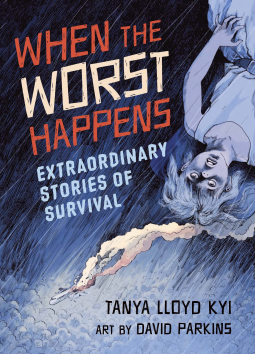SUMMARY FROM NETGALLEY.COM:
People overcome impossible odds where others surrendered and failed.
What would you do if you were stranded or trapped in a situation where you had to fight for your life? When the Worst Happens is a collection of intense, true stories set in distant corners of the earth.
After a fierce storm, the crew of the Polaris was stranded on an ice floe in the Arctic Ocean. A massive cave-in traps 19-year-old Jimmy Sanchez and 32 other Chilean miners deep below the earth. Twelve-year-old Bala and his two sisters must survive on a tiny island off the Australian coast after their boat capsizes. When her plane crashes in the Peruvian jungle, 17-year-old Juliane struggles to find help.
In extreme situations such as these, people can pull together, show almost super-human skill, and survive. But sometimes they face madness, greed or mutiny. These action-packed accounts reveal the critical decisions that determined the fate of each victim.
In an attempt to answer the question why people react the way they do in extreme circumstances, When the Worst Happens also looks at modern psychological studies, interesting historical details and settings, as well as seemingly unrelated events, to discover what draws the line between success and tragedy.
Graphic icons point readers to successful or poor decisions as each story unfolds, and outstanding illustrations capture the real-time developments in each riveting story.
MY TAKE:
Initially, it was the stories in the blurb that got me interested in the book.
In When the Worst Happens: Extraordinary Stories of Survival, readers are told stories of survival and how the people were able to get through their ordeal. The book also highlights the traits and things that people who survive tend to do, as well as the science behind fear and how we cope with crisis.
This book was actually more practical than I expected it to be. The icons next to specific parts of stories indicated which particular life-saving thing they did (keep calm, etc.).These "keys to survival" are listed at the start of the book and you can just refer to the list if you can't remember what the drawings stand for. These tips actually seem like common sense when you think about it, although given how many people in the stories mentioned in the book did the opposite, obviously, it's easier said than done.
There are four main stories that are told over the course of the book. In between each segment of each story, you'll be able to read about other stories of survival. The flow of the science and the stories were smooth, however, I would have preferred to read each of the main stories without having to read some other stories in between. By the time I reached the last parts of the book, I'd have to think back a little bit to try and remember what happened to the person that was just mentioned again after tens of pages.
While I thought the icons were cute, I wasn't really a fan of the illustration style used for the rest of the book. It reminded me of noir graphic novels. It's hard to explain but just look at the cover and you'll have an idea of what the illustrations in the book look like.
Thanks to NetGalley and Annick Press Ltd. for the e-ARC.
THE GOOD:
- There are some useful tips here.
- The stories are fascinating.
- The flow of stories and facts are more or less seamless.
THE BAD:
- The illustration style may not work for everyone.
READ IT IF:
- You like reading interesting stories.
- You want to teach your child what to do when he or she has to survive on his/her own.
- You like reading survival stories.
RATING:

SOUNDS INTERESTING?


No comments:
Post a Comment